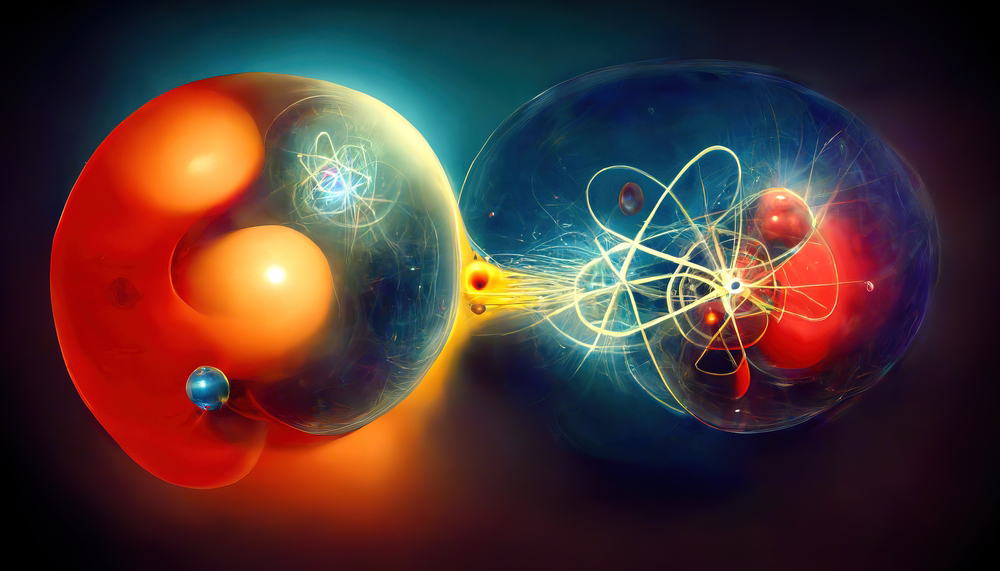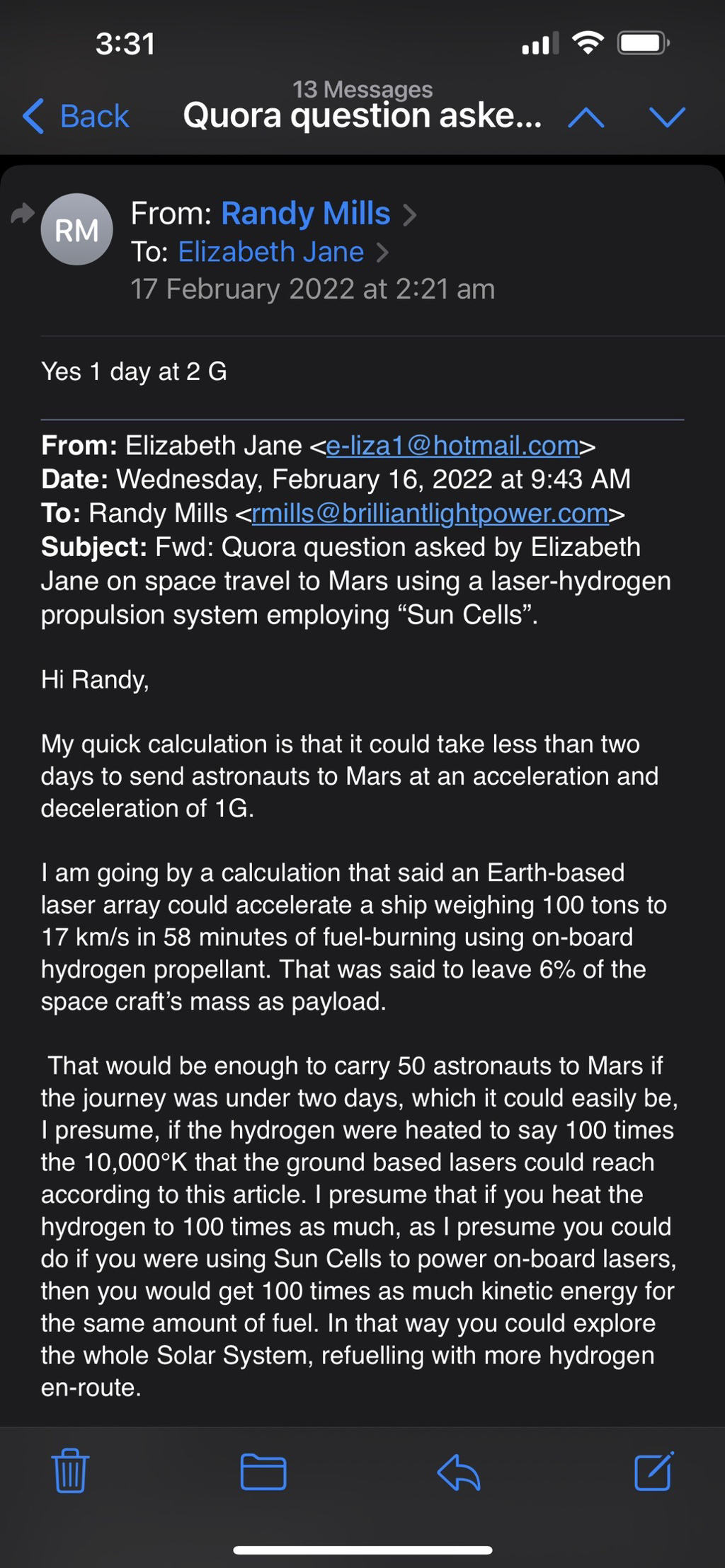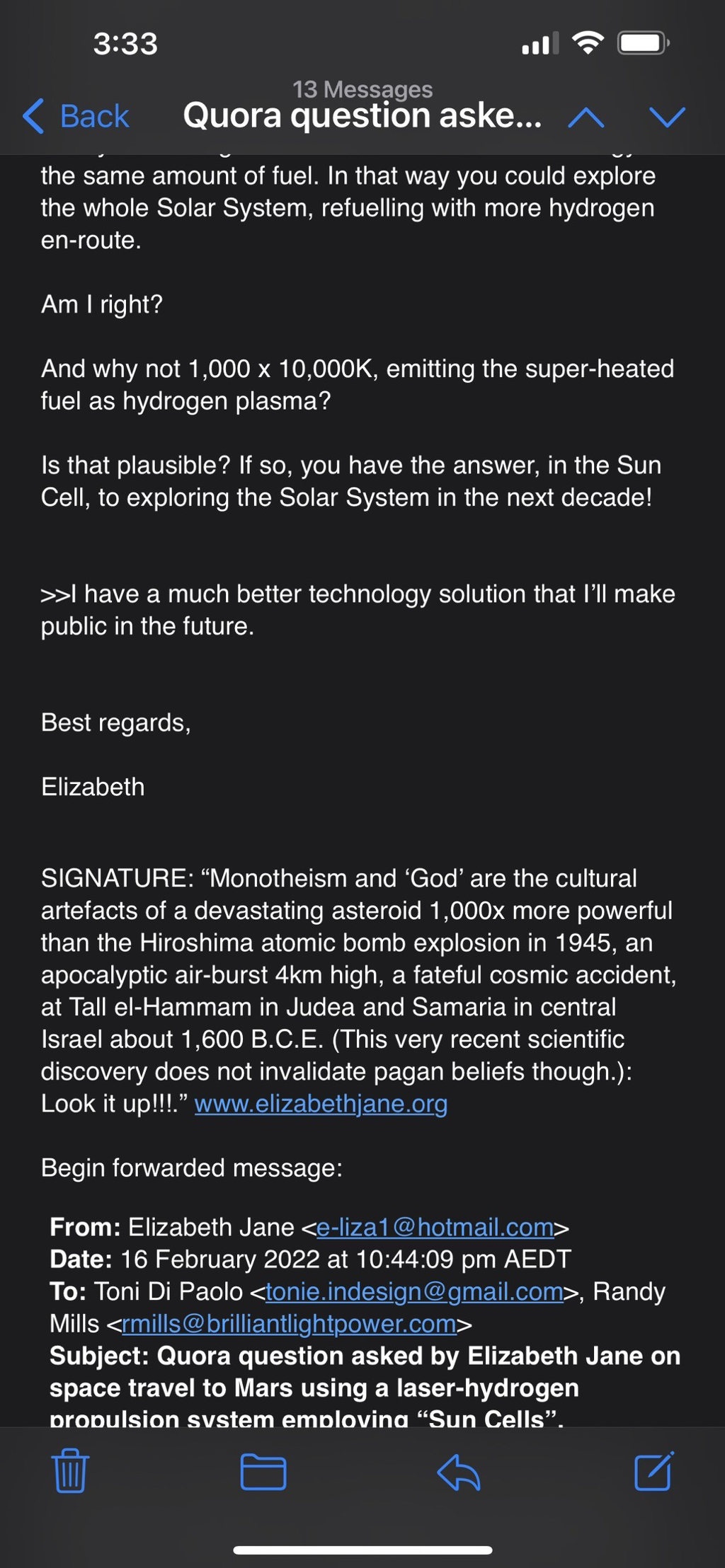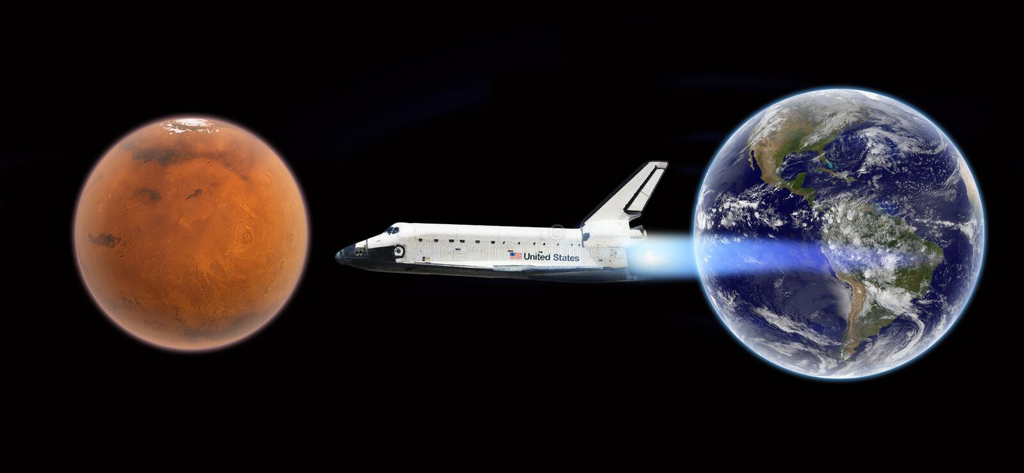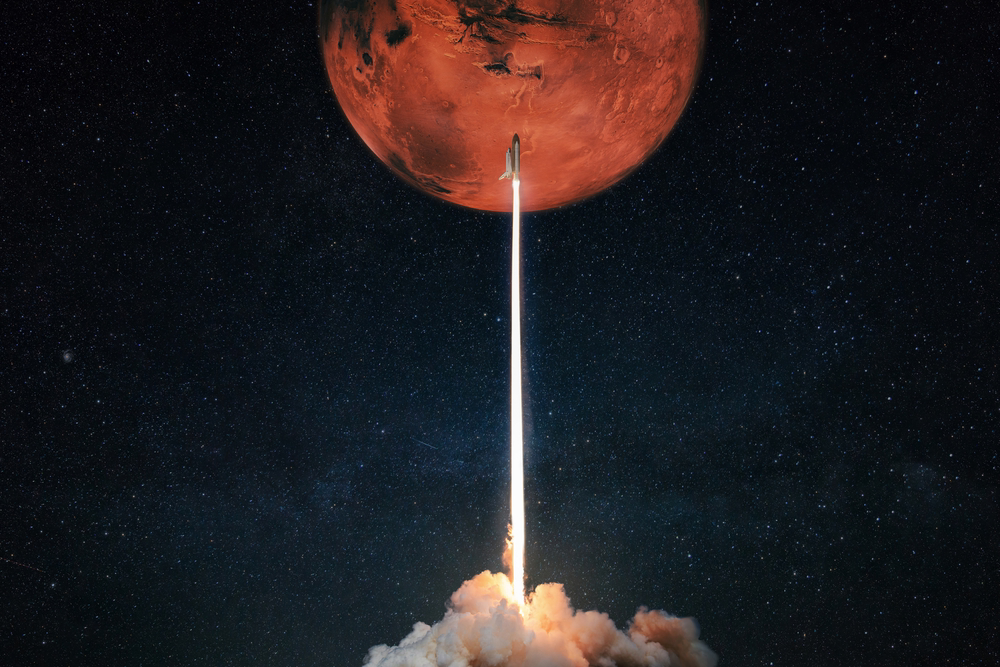We Can Now Travel to Mars
- in Just One Day!
Randell Mills, CEO of Brilliant Light Power, confirmed in an e-mail on the 17th February, 2022 that we can, using laser-hydrogen propulsion (a.k.a. laser-thermal propulsion) travel to Mars in one day at 2G using Sun Cells (TPV Sun Cells) to power the laser and using an on-board laser firing continuously increasing hydrogen propellant to much higher temperatures than 10,000°K rather than a ground based, Earth-based laser firing for just 58 minutes.
The suggestion was inspired by this article in Science Alert.
In an e-mail I sent him (quoted below) he confirmed that it was possible to complete a journey to Mars in one day: He replied: “Yes 1 day at 2G”!
He also said (amazingly): “I have a much better technology solution that I’ll make public in the future”.
I have sent this information to NASA and Tesla (I could not contact SpaceX directly).
The suggestion was inspired by this article in Science Alert.
In an e-mail I sent him (quoted below) he confirmed that it was possible to complete a journey to Mars in one day: He replied: “Yes 1 day at 2G”!
He also said (amazingly): “I have a much better technology solution that I’ll make public in the future”.
I have sent this information to NASA and Tesla (I could not contact SpaceX directly).
The Correspondence:
Yes 1 day at 2 G
From: Elizabeth Jane <[email protected]>
Date: Wednesday, February 16, 2022 at 9:43 AM
To: Randy Mills <[email protected]>
Subject: Fwd: Quora question asked by Elizabeth Jane on space travel to Mars using a laser-hydrogen propulsion system employing “Sun Cells”.
Hi Randy,
My quick calculation is that it could take less than two days to send astronauts to Mars at an acceleration and deceleration of 1G.
I am going by a calculation that said an Earth-based laser array could accelerate a ship weighing 100 tons to 17 km/s in 58 minutes of fuel-burning using on-board hydrogen propellant. That was said to leave 6% of the space craft’s mass as payload.
That would be enough to carry 50 astronauts to Mars if the journey was under two days, which it could easily be, I presume, if the hydrogen were heated to say 100 times the 10,000°K that the ground based lasers could reach according to this article. I presume that if you heat the hydrogen to 100 times as much, as I presume you could do if you were using Sun Cells to power on-board lasers, then you would get 100 times as much kinetic energy for the same amount of fuel. In that way you could explore the whole Solar System, refuelling with more hydrogen en-route.
Am I right?
And why not 1,000 x 10,000K, emitting the super-heated fuel as hydrogen plasma?
Is that plausible? If so, you have the answer, in the Sun Cell, to exploring the Solar System in the next decade!
>>I have a much better technology solution that I’ll make public in the future.
Best regards,
Elizabeth
SIGNATURE: “Monotheism and ‘God’ are the cultural artefacts of a devastating asteroid 1,000x more powerful than the Hiroshima atomic bomb explosion in 1945, an apocalyptic air-burst 4km high, a fateful cosmic accident, at Tall el-Hammam in Judea and Samaria in central Israel about 1,600 B.C.E. (This very recent scientific discovery does not invalidate pagan beliefs though.): Look it up!!!.” www.elizabethjane.org
Begin forwarded message:
From: Elizabeth Jane <[email protected]>
Date: 16 February 2022 at 10:44:09 pm AEDT
To: Toni Di Paolo <[email protected]>, Randy Mills <[email protected]>
Subject: Quora question asked by Elizabeth Jane on space travel to Mars using a laser-hydrogen propulsion system employing “Sun Cells”.
Question on @Quora: How long would it take to get to Mars at 1G using a laser-hydrogen power system and constant electric power with Brilliant Light Power’s “Sun Cells”? And supply ships at higher G’s? (See article.)
SIGNATURE: “Monotheism and ‘God’ are the cultural artefacts of a devastating asteroid 1,000x more powerful than the Hiroshima atomic bomb explosion in 1945, an apocalyptic air-burst 4km high, a fateful cosmic accident, at Tall el-Hammam in Judea and Samaria in central Israel about 1,600 B.C.E. (This very recent scientific discovery does not invalidate pagan beliefs though.): Look it up!!!.” www.elizabethjane.org
From: Elizabeth Jane <[email protected]>
Date: Wednesday, February 16, 2022 at 9:43 AM
To: Randy Mills <[email protected]>
Subject: Fwd: Quora question asked by Elizabeth Jane on space travel to Mars using a laser-hydrogen propulsion system employing “Sun Cells”.
Hi Randy,
My quick calculation is that it could take less than two days to send astronauts to Mars at an acceleration and deceleration of 1G.
I am going by a calculation that said an Earth-based laser array could accelerate a ship weighing 100 tons to 17 km/s in 58 minutes of fuel-burning using on-board hydrogen propellant. That was said to leave 6% of the space craft’s mass as payload.
That would be enough to carry 50 astronauts to Mars if the journey was under two days, which it could easily be, I presume, if the hydrogen were heated to say 100 times the 10,000°K that the ground based lasers could reach according to this article. I presume that if you heat the hydrogen to 100 times as much, as I presume you could do if you were using Sun Cells to power on-board lasers, then you would get 100 times as much kinetic energy for the same amount of fuel. In that way you could explore the whole Solar System, refuelling with more hydrogen en-route.
Am I right?
And why not 1,000 x 10,000K, emitting the super-heated fuel as hydrogen plasma?
Is that plausible? If so, you have the answer, in the Sun Cell, to exploring the Solar System in the next decade!
>>I have a much better technology solution that I’ll make public in the future.
Best regards,
Elizabeth
SIGNATURE: “Monotheism and ‘God’ are the cultural artefacts of a devastating asteroid 1,000x more powerful than the Hiroshima atomic bomb explosion in 1945, an apocalyptic air-burst 4km high, a fateful cosmic accident, at Tall el-Hammam in Judea and Samaria in central Israel about 1,600 B.C.E. (This very recent scientific discovery does not invalidate pagan beliefs though.): Look it up!!!.” www.elizabethjane.org
Begin forwarded message:
From: Elizabeth Jane <[email protected]>
Date: 16 February 2022 at 10:44:09 pm AEDT
To: Toni Di Paolo <[email protected]>, Randy Mills <[email protected]>
Subject: Quora question asked by Elizabeth Jane on space travel to Mars using a laser-hydrogen propulsion system employing “Sun Cells”.
Question on @Quora: How long would it take to get to Mars at 1G using a laser-hydrogen power system and constant electric power with Brilliant Light Power’s “Sun Cells”? And supply ships at higher G’s? (See article.)
SIGNATURE: “Monotheism and ‘God’ are the cultural artefacts of a devastating asteroid 1,000x more powerful than the Hiroshima atomic bomb explosion in 1945, an apocalyptic air-burst 4km high, a fateful cosmic accident, at Tall el-Hammam in Judea and Samaria in central Israel about 1,600 B.C.E. (This very recent scientific discovery does not invalidate pagan beliefs though.): Look it up!!!.” www.elizabethjane.org
Here is another relevant Quora question:
“Does a one g, continuous firing rocket solve the Mars trip issues of weightlessness, radiation exposure, and trip length?”
“Does a one g, continuous firing rocket solve the Mars trip issues of weightlessness, radiation exposure, and trip length?”
Here is a calculation of the time it would take to get to Mars at 1G on Quora:
“How short can a trip to Mars be, given fusion rockets capable of constant 1g acceleration?”
“How short can a trip to Mars be, given fusion rockets capable of constant 1g acceleration?”
